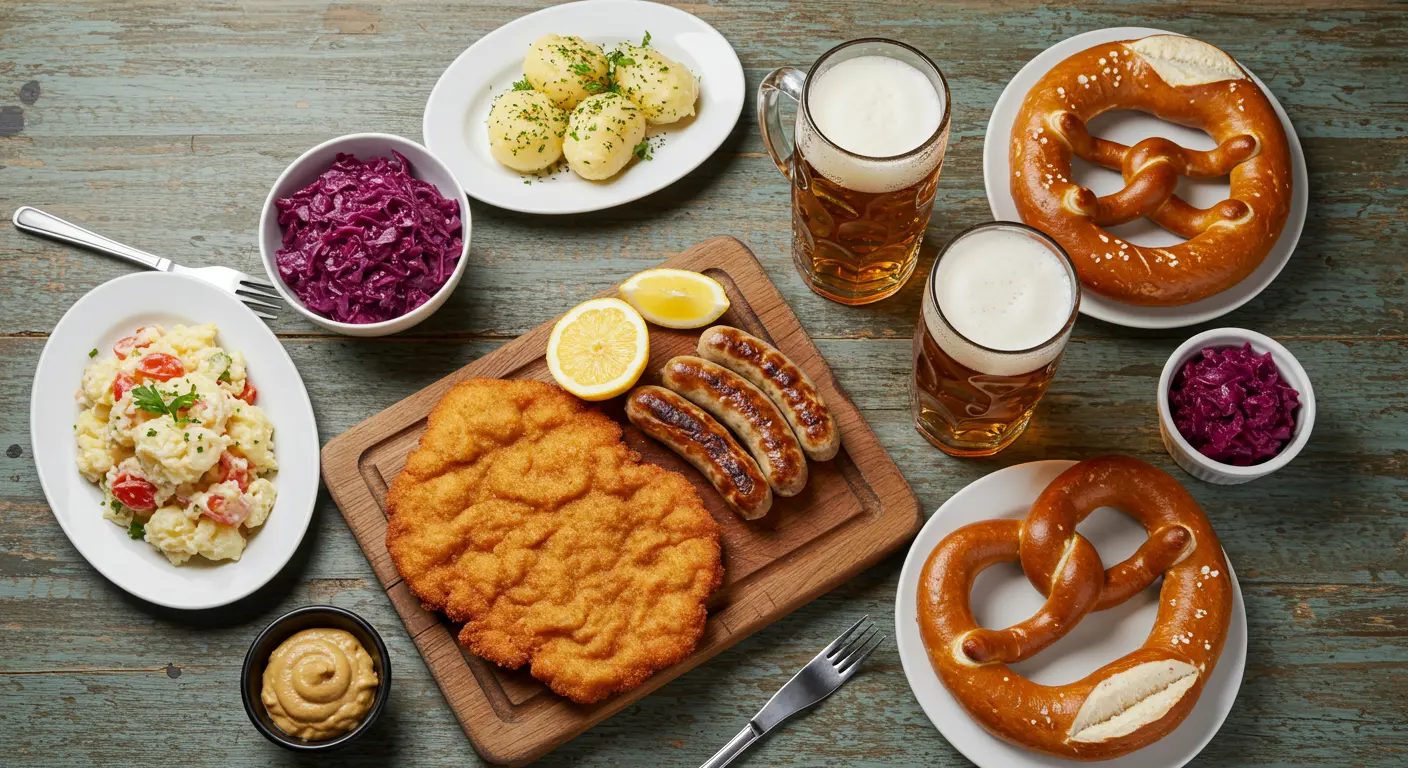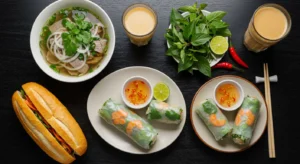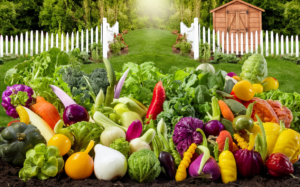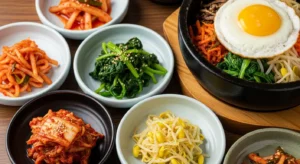Table of Contents
More Than Just Sausage: Your Friendly Guide to the Hearty World of German Food
Picture this: you’re sitting at a long, wooden table in a bustling beer hall, the air thick with laughter and the sound of a clinking Maßkrug (that’s a one-liter beer stein!). A plate arrives, steaming and generous, bearing a golden-brown schnitzel the size of your plate, next to a hearty heap of potato salad. This isn’t just a meal; it’s an experience. It’s the feeling of German food.
If your knowledge of German cuisine starts and ends with bratwurst and sauerkraut, you’re in for a treat. German food is a tapestry woven from regional diversity, deep-rooted traditions, and a focus on hearty, honest ingredients. It’s food that makes you feel comforted and satisfied. This guide is your first step into this wonderful world. We’ll demystify the menu, explore the classics, and uncover the stories behind the dishes that define Germany’s culinary soul.
The Foundation: What Makes German Food German?
Before we dive into specific dishes, it helps to understand the common threads. German cuisine, or Deutsche Küche, is often characterized by a few key principles. It’s less about delicate, fussy sauces and more about highlighting quality core components.
- Seasonal and Regional Pride: This is huge in Germany. You’ll hear terms like Spargelzeit (asparagus season) in the spring, where white asparagus is celebrated like a king. In the fall, it’s all about wild game and mushrooms. From the fish of the northern coasts to the cheeses of the Alpine south, what’s on your plate is deeply connected to the local landscape.
- The Holy Trinity: Bread, Potatoes, and Meat: These are the pillars. Germany boasts over 3,000 different types of bread, from dense, dark Pumpernickel to crunchy Roggenmischbrot. Potatoes (Kartoffeln) are a national obsession, prepared in countless ways. And while pork is the most popular meat, you’ll find plenty of beef, poultry, and game.
- Comfort and Satiation (Sättigung): German meals are designed to be satisfying. This is practical, home-style cooking born from a need for energy, often described as deftig—hearty and substantial. It’s the kind of food that sticks to your ribs on a cold day.
A Tour of the Table: Must-Try German Dishes for Beginners
Alright, let’s get to the good part. Here’s a curated list of dishes you’re likely to encounter. Think of this as your culinary cheat sheet.
The Superstars: Main Courses That Steal the Show
- Schnitzel: The ultimate comfort food. Traditionally, Wiener Schnitzel is made from veal and pounded thin, breaded, and fried to a perfect golden crisp. The more common version you’ll find is Schweineschnitzel (made from pork). It’s usually served with a lemon wedge squeeze of juice cuts through the richness beautifully, and either potato salad or fries. A key tip from my time in Bavaria: a true schnitzel is never served with gravy. That’s a different dish called Jägerschnitzel (Hunter’s Schnitzel), which is smothered in a mushroom sauce.
- Bratwurst & Co.: Yes, we have to talk about the sausage. But it’s not just one thing! There are over 1,500 varieties. The Bratwurst is a general term for a frying sausage, but each region has its champion. The long, thin Nürnberger Rostbratwurst is often served three-in-a-bun (Drei im Weckla). The thicker, curried Currywurst is a steamed and then fried pork sausage topped with a spiced ketchup curry sauce, a beloved street food icon in Berlin. It’s a perfect example of post-war innovation becoming a national treasure.
- Sauerbraten: This is a masterpiece of German patience. It’s a large piece of beef (or sometimes pork or venison) marinated for days in a mixture of vinegar, wine, and spices. This long marinating process makes the meat incredibly tender and flavorful. It’s then slow-roasted and typically served with a rich gravy, red cabbage (Rotkohl), and potato dumplings (Klöße). It’s a Sunday dinner classic.
- Rouladen: Another rolled-and-braised delight. Thin slices of beef are spread with mustard, filled with onions, bacon, and pickles, then rolled up and slow-cooked until fork-tender. The resulting gravy is dark, complex, and perfect for soaking up with those potato dumplings or Spätzle.
The Unsung Heroes: Sides and Staples
The main event is often elevated by its accompaniments. These sides are anything but an afterthought.
- Spätzle: These are soft egg noodles, a specialty from the south-west (especially Swabia). They have a delightful, slightly chewy texture and are the perfect vehicle for sauces. You’ll often find them topped with cheese as Käsespätzle, Germany’s incredibly indulgent answer to mac and cheese.
- Potato Dumplings (Klöße or Knödel): These soft, pillowy balls of grated or mashed potato are a staple, particularly in Thuringia and Bavaria. They are subtly flavored and designed to soak up the juices from your roast.
- Red Cabbage (Rotkohl or Blaukraut): Braised with apples, onions, and a touch of vinegar and spice, this sweet-and-sour side adds a vibrant color and flavor that cuts through the richness of meat dishes.
- Sauerkraut: The most famous side, but often misunderstood. Proper sauerkraut is finely cut cabbage fermented by various lactic acid bacteria. It’s tangy, a bit funky, and fantastic for digestion. It’s not just boiled and served; it’s often warmed with a bit of white wine, juniper berries, or caraway seeds to enhance its flavor.
The Social Side: Where and How to Eat Like a Local
German dining is a social affair. Here’s how to navigate it.
- The Gasthaus/Gasthof: This is your go-to for an authentic experience. It’s a traditional inn or pub, often family-run, serving classic regional dishes. The atmosphere is cozy and unpretentious.
- The Beer Garden (Biergarten): An institution, especially in Bavaria. These outdoor areas, often under the shade of chestnut trees, are for communal drinking and eating. It’s common to share a table with strangers. Food here is simple and hearty: giant pretzels (Brezn), radishes, Obatzda (a delicious cheese and beer spread), and of course, roast chicken (Hendl).
- Brotzeit: Meaning “bread time,” this is the German version of a snack or light meal, often enjoyed in the afternoon or evening. It typically involves a selection of breads, cheeses, cold cuts, and pickles. It’s perfect for when you want something less formal than a full dinner.
A Sweet Ending: German Desserts
You can’t talk about German food without mentioning the desserts. Beyond the world-famous Black Forest Cake (Schwarzwälder Kirschtorte), look for Apfelstrudel (warm apple strudel with vanilla sauce) or Rote Grütze (a red berry compote served with vanilla sauce or cream). Around Christmas, the markets are filled with the scent of Lebkuchen (gingerbread) and Stollen (a fruity bread dusted with powdered sugar).
Cheers! A Note on German Drinks
Of course, beer is synonymous with Germany. It’s not just a drink; it’s part of the culture, governed by the Reinheitsgebot (Beer Purity Law) since 1516, which originally stipulated that beer could only be made from water, barley, and hops. But don’t overlook the wines, especially the crisp Rieslings from the Mosel Valley or the refreshing Apfelschorle—a simple mix of apple juice and sparkling water that’s the default non-alcoholic drink for all ages.
Ready to Explore?
German food is a journey of discovery. It’s about embracing the hearty, celebrating the seasons, and sharing a table with others. So, find a local German restaurant or, better yet, start planning a trip. Don’t be afraid to point at something on the menu you don’t recognize. The best culinary adventures often start with a little curiosity.
Frequently Asked Questions About German Food
Q: Is German food always heavy and meat-centric?
A: While hearty dishes are a big part of the tradition, modern German cuisine has evolved. You’ll find plenty of lighter options, especially around coastal areas with fish, and vegetarianism is growing. Classics like Käsespätzle (cheese noodles) or Flammkuchen (a thin, crispy pizza-like tart with crème fraîche, onions, and bacon) offer variety. Seasonal vegetables, like white asparagus in spring, are also celebrated with light preparations.
Q: What is a typical German breakfast?
A: A typical German breakfast (Frühstück) is often cold and centered around bread. It includes a selection of rolls (Brötchen) or slices of darker bread, with an array of toppings: cold cuts (Aufschnitt), cheeses, jams, honey, and boiled eggs. It’s a simple, leisurely way to start the day.
Q: I’m visiting Germany. What’s one thing I should know about dining etiquette?
A: A simple and important one is to say “Prost!” (Cheers!) before taking your first sip of beer. And when you do, make sure you look your drinking partners in the eye. It’s a sign of respect, and legend says failing to do so brings seven years of bad luck in the bedroom!
Q: What’s the difference between a Bratwurst and a Wiener?
A: This is a common point of confusion. “Bratwurst” is a German term for a finely minced sausage meant for frying or grilling. A “Wiener” (as in Wiener Würstchen or Vienna sausage) is typically a parboiled sausage, softer and skinnier, like the frankfurters you might put in a hot dog. They have different preparations and textures.
Q: Where can I learn more about the regional diversity of German cuisine?
A: A fantastic resource is the official website of the German National Tourist Board (I’ll link to their food and drink section here: https://www.germany.travel/en/culinary-germany/culinary-germany.html). It offers deep dives into the specific specialties of each federal state.
So, there you have it. German food is so much more than a single stereotype. It’s a rich, regional, and deeply comforting cuisine waiting to be explored. Now, who’s hungry?




